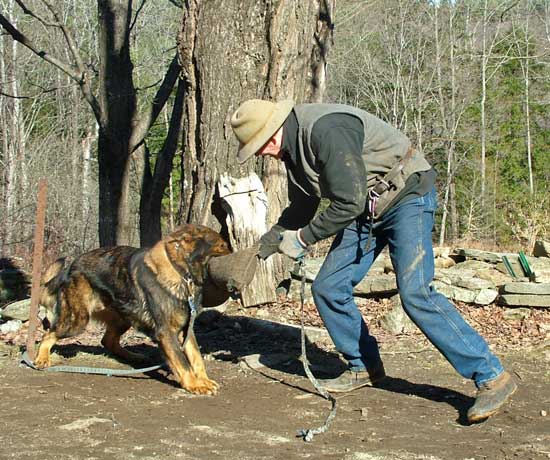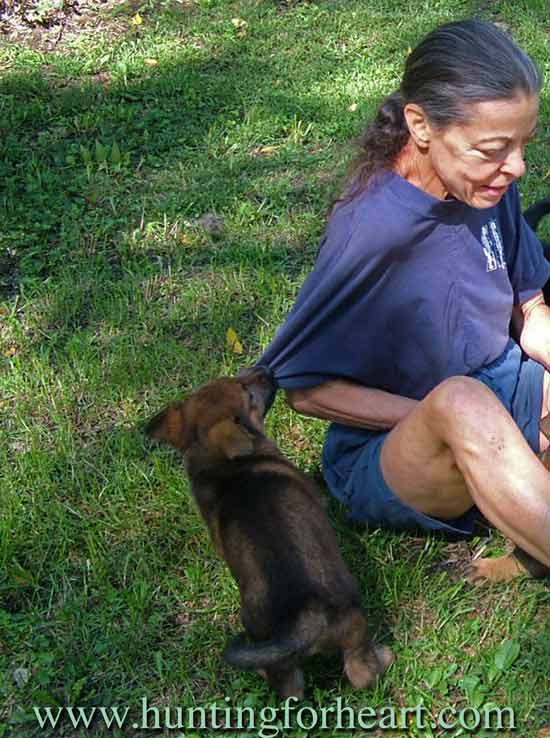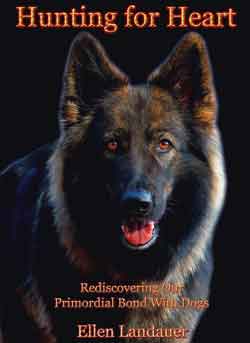Playing Tug With Your Dog
by Ellen Landauer
Playing tug with your dog: Teaching him WHAT to bite rather than NOT to bite is a great way to increase the bond between you.

PHOTO ABOVE: Natural Dog Training originator, Kevin Behan, playing tug with a dog.
__________________________
The differences between Natural Dog Training and other methods of negotiating the challenges of a dog's desire to grip with their jaws are:
- Virtually all other methods promote control or suppression of dog's emotional intensity.
- Natural Dog Training works best because it enables your canine companion to cooperate with you when they are highly excited.
- Most methods work on limiting the level of excitement, suppressing natural desire and supple way of moving in puppies and dogs.
- Playing tug with your dog the Natural Dog Training way, enables your pup to be open to your direction even at peak drive and excitement. It also eases your fear because you learn that the wild part of your dog is exactly what enables them to be the most cooperative animal on earth.
- Virtually all other methods have you working against a force of nature - your dog's desire to get to the excitement and fulfillment of the hunt.
- Playing tug with your dog the right way gives you and him an object in common, a common goal, and joins you at the heart in the passion of the hunt.
BELOW, we elaborate on the above differences between our method and most all other training.
Playing Tug With Your Dog:
Why it's Not Promoted
Playing tug with your dog is frowned upon by nearly all conventional trainers.
Why??
At the root of most training is FEAR of the true nature of dogs. Even 'kinder/gentler' methods, while they don't openly admit it, are contaminated with this fear. More forceful methods tell you that you need to prove to your dog that you are the 'Boss.'
This counterproductive mindset pits owner and dog against each other in an adversarial relationship. It erodes - rather than building -trust and cooperation.
Playing Tug With Your Dog:
Save the Puppies!
When growing pups are most full of life, they are almost always disciplined. The treatment most pups are subjected to in the name of 'preventing behavior problems,' 'preventing aggression' and even house training has the exact opposite of its intended effect.
Conventional training results in a growing dog that is inhibited and frustrated. (Included in that category are: behavior modification, clicker training, operant conditioning (punishing 'bad' behaviors and reinforcing good ones), aversive-based (discipline/punishment), dominance, etc.
To find an outlet for their energy, pups resort to expressing it in ways we call behavior problems. Rather than nurturing a pup's aliveness, conventional training seeks to crush it.
Often, punishment in the form of reprimands, leash correction or 'time out' (ignoring the pup) is employed to control what is seen as excess excitement.
____________________________
- Virtually all other training methods promote control and suppression of a dog's emotional intensity. They don't encourage us to be open to safely receive ALL the drive and strength of will the pup wants to give. If your pup can't give that to you, they will look elsewhere, eroding trust and bonding. If you are the one to lead them to that exalted state, you will be the most desired one in all situations.
- Natural Dog Training works best because it enables your dog to cooperate with you when their energy and excitement is highest. Other methods inhibit the dog's drive so the dog has to work in an inhibited state - bringing the dog's energy level down to be 'manageable.'
- When dogs are excited, that is when most people lose control of them. That is because every time they got excited as a puppy (chewing the couch, jumping on people, etc., YOU were the one to crush that excitement. Therefore, your pup feels they have to get away from you to get the satisfying activity they crave.
Ideally, you want your canine companion to be able to function in harmony with you in the most challenging, highly-charged situations. Among other things, this helps keep them safe. Playing tug with your pup opens the way to the exalted connection of the Primordial Bond - which is a rarity between dogs and their owners.
- Most methods work on limiting the level of excitement, suppressing natural desire and free-flowing way of moving in puppies and dogs.
No matter what they say, it is about controlling impulses we fear.
- Playing tug with your dog the Natural Dog Training way, enables your pup to be open to your direction even at peak drive and excitement. It gives you a way to attract your dog when other tempting distactions beckon. It also eases your fear because you learn that the wild part of your dog is exactly what enables them to be the most cooperative animal on earth.
- Virtually all other methods have you working against a force of nature - your dog's desire to get to the excitement and fulfillment of the hunt. This is hard work for you and unfulfilling for your companion. It also creates an emotional wedge between you - a gap in the connectedness we long for with our pups. That gap is why for most owners, when a dog is at peak drive, all control is lost. All that bribing and compulsion that makes dog obedience 'look good' breaks down and the dog looks to other means than the owner to fulfill what they most want (most call that 'disobedience').
Playing tug with your dog the right way gives you and him an object in common, a common goal, and joins you at the heart in the passion of the hunt.
Playing Tug With Your Dog:
the Opposite of 'Bite Inhibition'
Playing tug with your dog allows you and your pet to bond through shared excitement. This is the opposite of the repressive method called 'bite inhibition.'
You will find endless articles on 'bite inhibition,' 'time out,' 'ignore the dog when they try to bite.'
Bite inhibition instructions generally are as follows. 'As soon as the puppy or dog puts their mouth on you with ANY pressure, you are to emit a 'yelp' that tells them they are hurting you.
In my experience, the 'yelp' is more like a shriek - or sometimes takes the form of an angry bellowing sound. Both of these can be scary to a pup of moderate temperament. However in a pup of strong temperament, a shriek or bellow can be very stimulating. (That is why toys that emit a squealing sound are so appealing to our canine pets).
Playing tug with your dog captures and channels the energy behind their desire to grip something with their jaws. Rather than feeling repressed and disconnected emotionally from you, this game brings you and your companion into perfect harmony.
Why?
Because your pup is getting their hearts desire THROUGH YOU, and you both are enjoying an object in common.
Playing tug with your dog the RIGHT way is the key to this joyful state of affairs.
Playing Tug With Your Dog: How to Start?
Right from the beginning, a puppy is easy to train in this satisfying game. This is because a young pup is (generally) far more open and emotionally available than a dog who has been punished for being open and desirous.
However a repressed, emotionally compromised mature dog will take some time and patience on your part. Virtually ALL rescue dogs have had their natural way of moving and expressing emotion suppressed with varying levels of severity.
Like a person who was misunderstood or abused as a child, the scars can run deep. When you see a lack of composure, openness and directness in a canine companion, you are seeing a less-than-ideal past.
Playing Tug With Your Dog: Puppy Training
The most important thing that will make it easy to play tug with your dog is to NEVER frighten a pup out of putting their mouth on you.
Very young pups should just be provided the toy as substitute for biting you. You can gently stroke or tap their sides with it to attract them to bite it, then briefly (10 seconds or so) let them push and pull and wrestle with toy then let them run about with it. Not much to do until they are 4 - 6 months old. NEVER insist pup give you the toy - that comes later. Just provide food treats and gently put toy back on your belt while they are totally engaged with food.
Next most important thing is - when playing tug with your4 - 6 months old dog, they should always win! NEVER overpower them and steal the toy.
Once they have a good grip on the toy, cheer them on a bit and run away. Have a long line attached to their collar so they don't just run off with the toy and chew on it. Hopefully they will follow you, but if they don't, you have the long line to calmly keep them near.
Run about with them carrying the toy, then provide a few treats so they lose interest in the toy and drop it, which you then put back on your belt. You can lead the dog away after he drops the toy and is chewing his treat, so he won't try to grab it as you are picking it up (though that is a good thing as it shows his drive for the toy). Do not let pup chew on bite toy - its sole purpose is to unite you and pup in the 'hunt.'
Whenever you spend time with your pup, always be prepared with a treat-filled food pouch and a bite toy on your belt. That way, you have no cause to complain about them wanting to bite.
If pup is gripping you with their jaws and it feels fairly benign, no need to overstimulate them with toys and treats. The more relaxed you are, the more likely your pup will be also - and the less tension in their jaws. Keep your hand (or whatever part of you pup is gripping) ultra-relaxed. That will help soften pup's intensity. If you are tense or afraid, there will be more tension in pup's jaws and it will become more uncomfortable for you.
If pup's grip becomes uncomfortable, toy or treats give them something other than you to bite, so can be used as satisfying substitute.
Once a pup is 4 - 6 months old, you can play 'keep away.' With another person, toss the toy back and forth between you, doing your best to grab it before the puppy does. This builds drive for the toy - making it of increasing value. In the future, it will help your dog tune out distractions in preference to playing with you.

PHOTO ABOVE: Playing tug with your dog comes easily when you open to the natural desire of your puppy to make contact - right from the beginning.
Playing Tug With Your Dog: Mature Dogs
Playing tug with your dog whether puppy or grown requires some preparatory work. Getting the Food and Pushing exercise really good is first.
If your dog is hesitant or not interested in engaging with you through a bite toy, you need to build the Food and Pushing more deeply.
Particularly for a dog that is uninterested, a good way to start is playing 'keep away.' You can do this solo or with a friend. What you want, your dog will want.
To make it easier, and limit distractions that your dog may get interested in off lead, tying him out on a sturdy line about 10 feet long is a good idea. He should be wearing a comfortable flat collar. Ideally, you can use a bungee tie-out; these are available through some working dog sites.
One important thing is, do not give eye contact and verbal or other invitation to your dog to play. It is you - or you and a friend - having a grand time throwing, chasing and snatching the toy - that will be most effective in attracting your pup.
Also, do not run at your dog in this game - rather run by him. You don't want to put pressure on him. You may want to start out at 20 - 30 feet away and then gradually move the game closer.
If the dog begins to show some interest, try letting the toy land within 6 feet of him, then snatch it away. If that sparks more intensity, running by and flashing the toy just within his reach may get him to grab it.
If he grips firmly enough to possess the toy with a little resistance from you, attach a lead and unhook him from the tie-out. (If he drops the toy, run with him away from it and end the session until next time).
Assuming he keeps a good grip on the toy, run with him holding it and cheer him on a bit verbally. If he drops it, walk him away and hook him up, pick up the toy (it is good if he sees you do that). Put the toy out of reach (hang on a wall or post, etc.) and end the session there.
In playing tug with your dog, it is good to end the game BEFORE your dog drops the toy or loses interest. You want to build drive for the toy as time goes on. Using treats to disengage him from the toy is a great way to make it easy.
BUY 'Hunting for Heart' and
Rediscover Your Primordial Bond With Dogs
BUY the
Book
HEALTH INFO
FOR YOU
My other website:
Peak health helps you have more energy to enjoy your dog!
